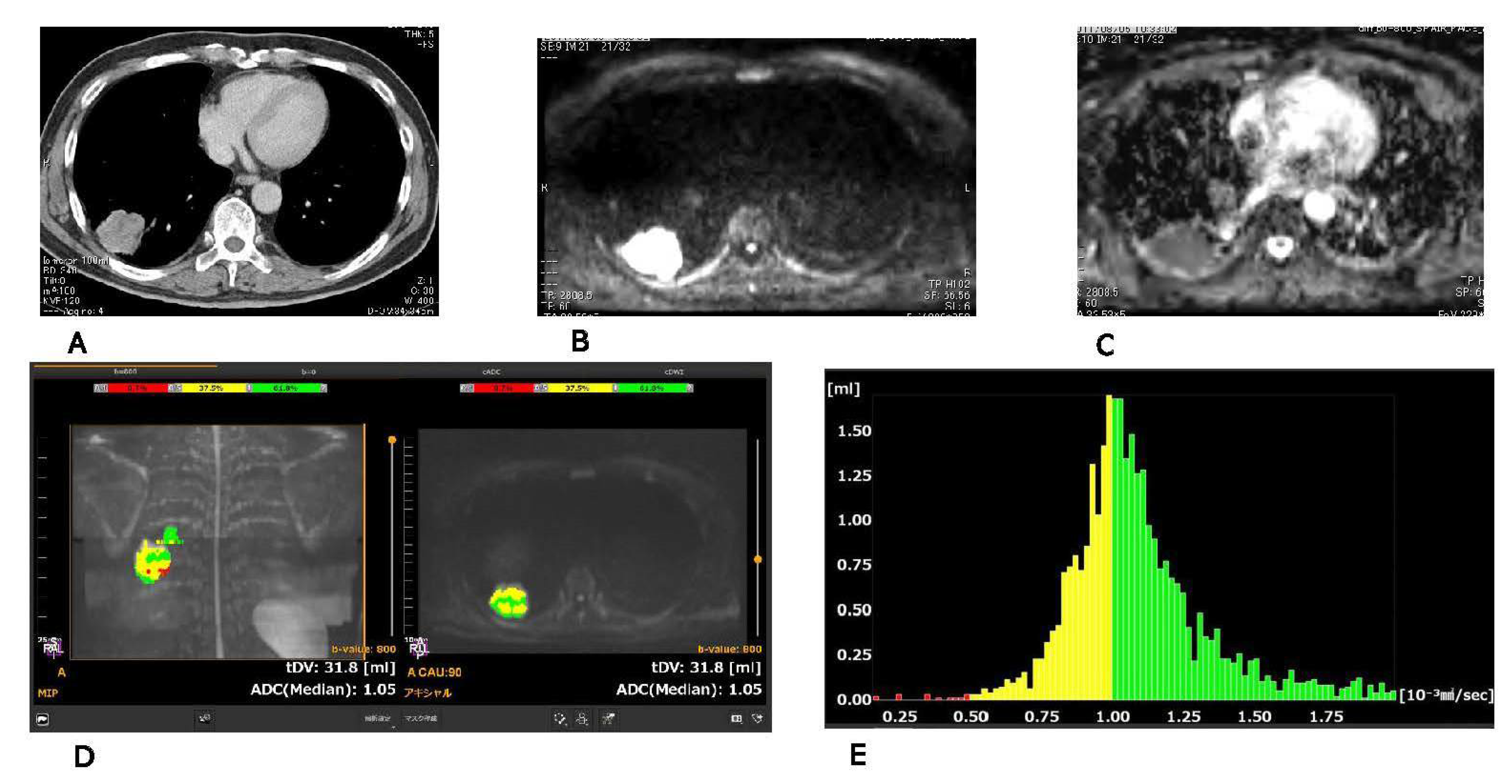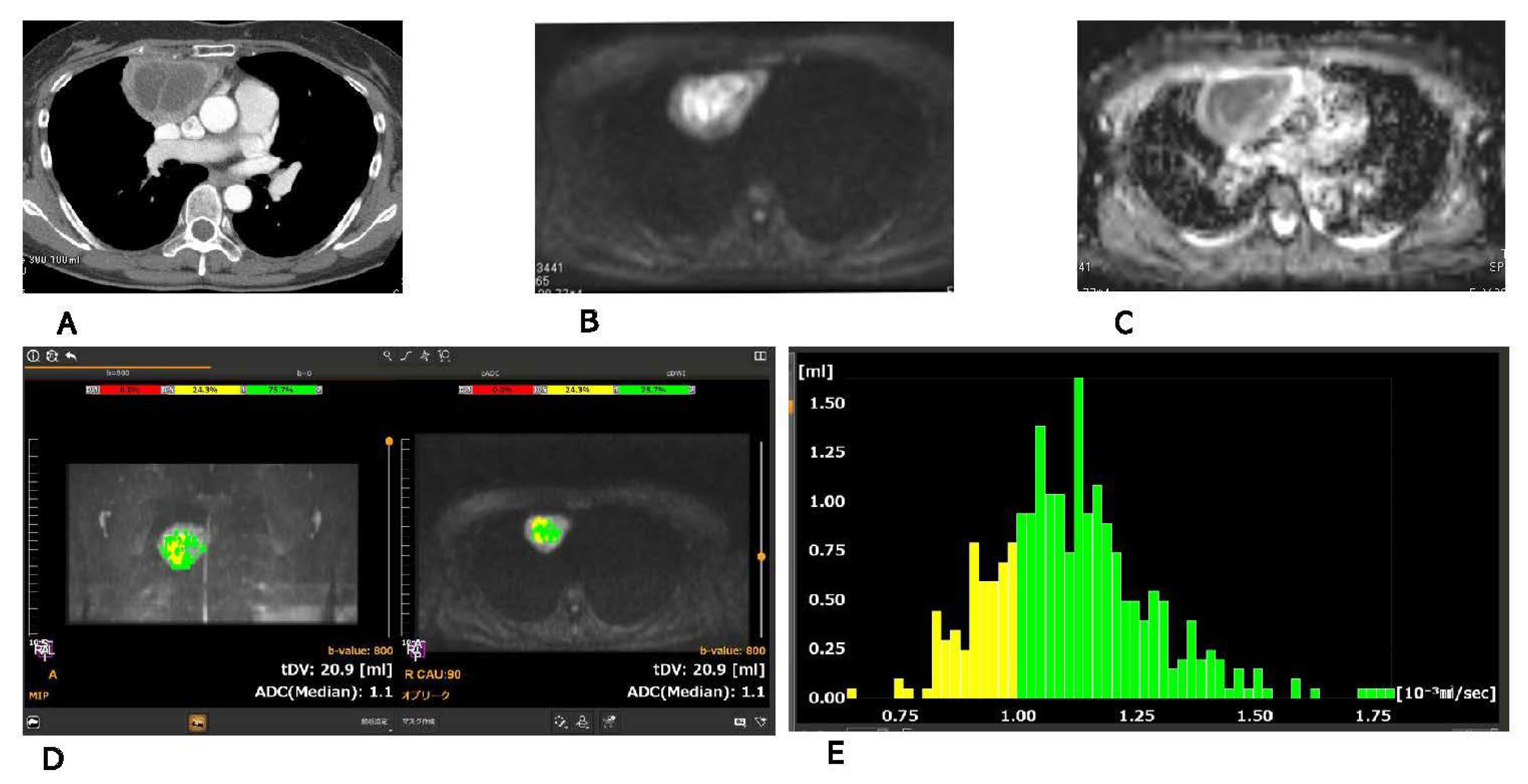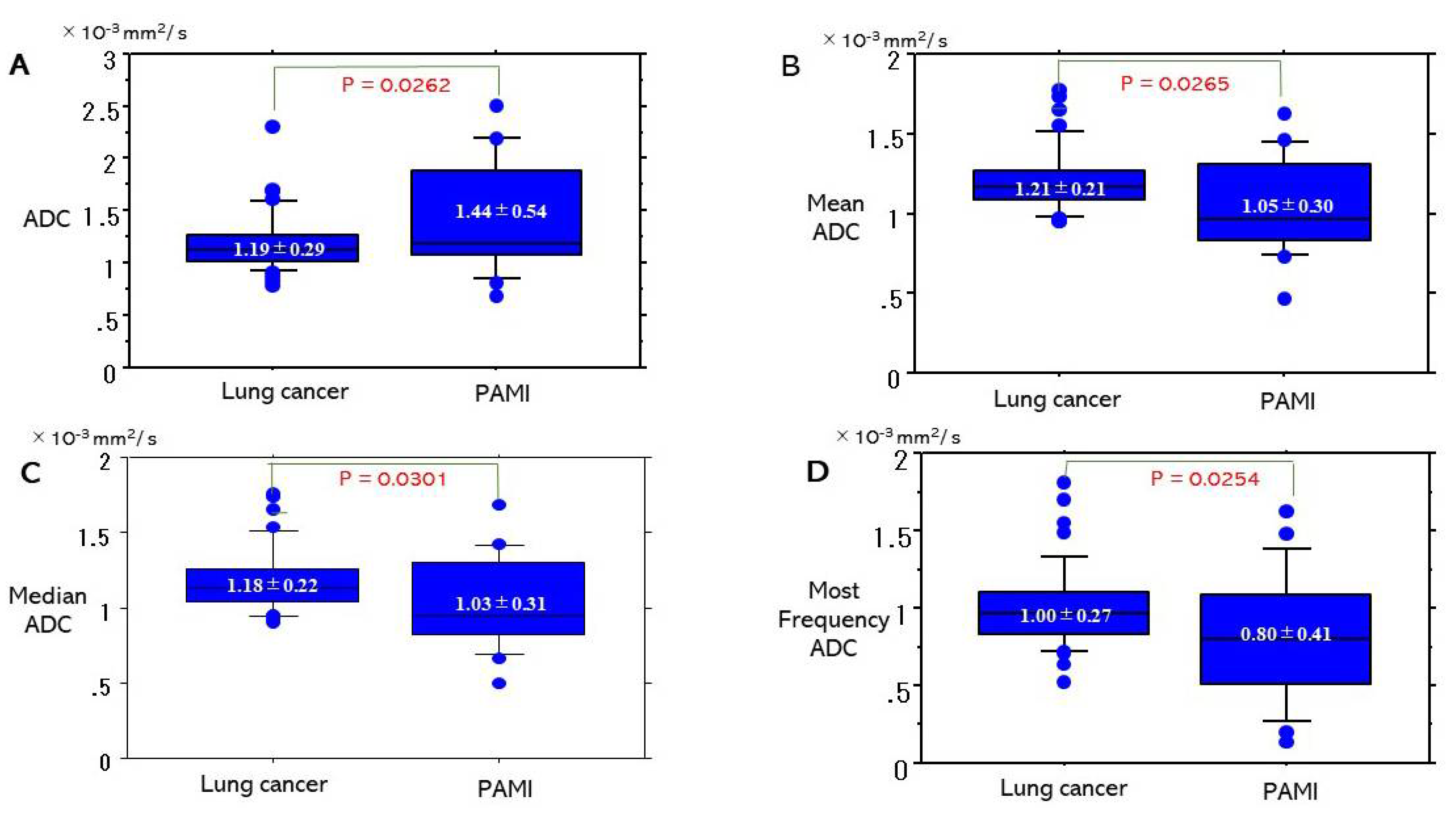Whole-Lesion Apparent Diffusion Coefficient Histogram Analysis: Significance for Discriminating Lung Cancer from Pulmonary Abscess and Mycobacterial Infection
Abstract
Simple Summary
Abstract
1. Introduction
2. Materials and Methods
2.1. Eligibility
2.2. Patients
2.3. MR Imaging
2.4. Statistical Analysis
3. Results
4. Discussion
5. Conclusions
Author Contributions
Funding
Institutional Review Board Statement
Informed Consent Statement
Data Availability Statement
Acknowledgments
Conflicts of Interest
References
- Could, M.K.; Maclean, C.C.; Kuschner, W.G.; Rydzak, C.E.; Owens, D.K. Accuracy of positron emission tomography for diagnosis of pulmonary nodules and mass lesions. A meta-analysis. JAMA 2001, 285, 914–924. [Google Scholar]
- Goo, J.M.; Im, J.G.; Do, K.H.; Yeo, J.S.; Seo, J.B.; Kim, H.Y.; Chung, J.K. Pulmonary tuberculoma evaluated by means of FDG PET. Findings in 10 cases. Radiology 2000, 216, 117–121. [Google Scholar] [CrossRef]
- Cheran, S.K.; Nielsen, N.D.; Patz, E.F. False-negative findings for primary lung tumors on FDG positron emission tomography. Staging and prognostic implications. Am. J. Roentgenol. 2004, 182, 1129–1132. [Google Scholar] [CrossRef] [PubMed]
- Satoh, Y.; Ichikawa, T.; Motosugi, U.; Kimura, K.; Sou, H.; Sano, K.; Araki, T. Diagnosis of peritoneal dissemination. Comparison of 18F-DDG PET/CT, diffusion-weighted MRI, and contrast-enhanced MDCT. Am. J. Roentgenol. 2011, 196, 447–453. [Google Scholar] [CrossRef] [PubMed]
- Le Bihan, D.; Breton, E.; Lallemand, D.; Aubin, M.L.; Vignaud, J.; Laval-Jeantet, M. Separation of diffusion and perfusion in intravoxel incoherent motion MR imaging. Radiology 1988, 168, 497–505. [Google Scholar] [CrossRef] [PubMed]
- Wu, L.M.; Xu, J.R.; Hua, J.; Gu, H.Y.; Chen, J.; Haacke, E.M.; Hu, J. Can diffusion-weighted imaging be used as a reliable sequence in the detection of malignant pulmonary nodules and masses? Magn. Reson. Imaging 2013, 31, 235–246. [Google Scholar] [CrossRef]
- Mori, T.; Nomori, H.; Ikeda, K.; Kawanaka, K.; Shiraishi, S.; Katahira, K.; Yamashita, Y. Diffusion-weighted magnetic resonance imaging for diagnosing malignant pulmonary nodules/masses. Comparison with positron emission tomography. J. Thoracic. Oncol. 2008, 3, 358–364. [Google Scholar] [CrossRef]
- Tondo, F.; Saponaro, A.; Stecco, A.; Lombardi, M.; Casadio, C.; Carriero, A. Role of diffusion-weighted imaging in the differential diagnosis of benign and malignant lesions of the chest-mediastinum. Radiol. Med. 2011, 116, 720–733. [Google Scholar] [CrossRef]
- Yamamura, J.; Salomon, G.; Buchert, R.; Hohenstein, A.; Graessner, J.; Huland, H.; Graefen, M.; Adam, G.; Wedegaertner, U. Magnetic resonance imaging of prostate cancer. Diffusion-weighted imaging in comparison with sextant biopsy. J. Comput. Assist. Tomogr. 2011, 35, 223–228. [Google Scholar] [CrossRef]
- Fornasa, F.; Pinali, L.; Gasparini, A.; Toniolli, E.; Montemezzi, S. Diffusion-weighted magnetic resonance imaging in focal breast lesions. Analysis of 78 cases with pathological correlation. Radiol. Med. 2011, 116, 264–275.rt4. [Google Scholar] [CrossRef]
- Koike, N.; Cho, A.; Nasu, K.; Seto, K.; Nagaya, S.; Ohshima, Y.; Ohkohchi, N. Role of diffusion-weighted magnetic resonance imaging in the differential diagnosis of focal hepatic lesions. World J. Gastroenterol. 2009, 15, 5805–5812. [Google Scholar] [CrossRef]
- Xue, H.; Ren, C.; Yang, J.; Sun, Z.; Li, S.; Jin, Z.; Shen, K.; Zhou, W. Histogram Analysis of Apparent Diffusion Coefficient for the Assessment of Local Aggressiveness of Cervical Cancer. Arch. Gynecol. Obstet. 2014, 290, 341–348. [Google Scholar] [CrossRef] [PubMed]
- Donati, O.F.; Mazaheri, Y.; Faq, A.; Vargas, H.A.; Zheng, J.; Moskowitz, C.S.; Hricak, H.; Akin, O. Prostate Cancer Aggressiveness: Assessment With Whole-Lesion Histogram Analysis of the Apparent Diffusion Coefficient. Radiology 2014, 271, 143–152. [Google Scholar] [CrossRef] [PubMed]
- Tsuchiya, N.; Doai, M.; Usuda, K.; Uramoto, H.; Tonami, H. Non-small cell lung cancer: Whole-lesion histogram analysis of the apparent diffusion coefficient for assessment of tumor grade, lymphovascular invasion and pleural invasion. PLoS ONE 2017, 12, e0172433. [Google Scholar] [CrossRef]
- Usuda, K.; Zhao, X.T.; Sagawa, M.; Matoba, M.; Kuginuki, Y.; Ueda, Y.; Sakuma, T. Diffusion-weighted imaging is superior to PET in the detection and nodal assessment of lung cancers. Ann. Thorac. Surg. 2011, 91, 1689–1695. [Google Scholar] [CrossRef] [PubMed]
- Li, B.; Li, Q.; Chen, C.; Guan, Y.; Liu, S. A systematic review and meta-analysis of the accuracy of diffusion-weighted MRI in the detection of malignant pulmonary nodules and masses. Acad. Radiol. 2014, 21, 21–29. [Google Scholar] [CrossRef]
- Shen, G.; Jia, Z.; Deng, H. Apparent diffusion coefficient values of diffusion-weighted imaging for distinguishing focal pulmonary lesions and characterizing the subtype of lung cancer: A meta-analysis. Eur. Radiol. 2016, 26, 556–566. [Google Scholar] [CrossRef]
- Szafer, A.; Zhong, J.; Gore, J.C. Theoretical model for water diffusion in tissues. Magn. Reason. Med. 1995, 33, 697–712. [Google Scholar] [CrossRef]
- Liu, H.; Liu, Y.; Yu, T.; Ye, N. Usefulness of diffusion-weighted MR imaging in the evaluation of pulmonary lesions. Eur. Radiol. 2010, 20, 807–815. [Google Scholar] [CrossRef]
- Coolen, J.; De Keyzer, F.; Nafteux, P.; Wever, W.D.; Dooms, C.; Vansteenkiste, J.; Roebben, I.; Verbeken, E.; Leyn, P.D.; Raemdonck, D.V.; et al. Malignant pleural disease: Diagnosis by using diffusion-weighted and dynamic contrast-enhanced MR imaging-initial experience. Radiology 2012, 263, 884–892. [Google Scholar] [CrossRef]
- Usuda, K.; Sagawa, M.; Motono, N.; Ueno, M.; Tanaka, M.; Machida, Y.; Maeda, S.; Matoba, M.; Kuginuki, Y.; Taniguchi, M.; et al. Diagnostic performance of diffusion weighted imaging of malignant and benign pulmonary nodules and masses: Comparison with positron emission tomography. Asian Pac. J. Cancer Prev. 2014, 15, 4629–4635. [Google Scholar] [CrossRef]
- Chun, C.W.; Jung, J.Y.; Baik, J.S.; Jee, W.H.; Kim, S.K.; Shin, S.H. Detection of soft-tissue abscess: Comparison of diffusion-weighted imaging to contrast-enhanced MRI. J. Magn. Reson. Imaging 2018, 47, 60–68. [Google Scholar] [CrossRef]
- Kwee, T.C.; Takahara, T.; Ochiai, R.; Koh, D.-M.; Ohno, Y.; Nakanishi, K.; Niwa, T.; Chenevert, T.L.; Luijten, P.R.; Alavi, A. Complementary roles of whole-body diffusion-weighted MRI and 18F-FDG PET. The state of the art and potential application. J. Nucl. Med. 2010, 51, 1549–1558. [Google Scholar] [CrossRef] [PubMed]
- Desprechins, B.; Stadnik, T.; Koerts, G.; Shabana, W.; Breucq, C.; Osteaux, M. Use of diffusion-weighted MR imaging in differential diagnosis between intracerebral necrotic tumors and cerebral abscesses. Am. J. Neuroradiol. 1999, 20, 1252–1257. [Google Scholar]
- Xu, X.X.; Li, B.; Yang, H.F.; Du, Y.; Li, Y.; Wang, W.-X.; Zheng, H.-J.; Gong, Q.-Y. Can diffusion-weighted imaging be used to differentiate brain abscess from other ring-enhancing brain lesions? A meta-analysis. Clin. Radiol. 2014, 69, 909–915. [Google Scholar] [CrossRef] [PubMed]
- Ebisu, T.; Tanaka, C.; Umeda, M.; Kitamura, M.; Naruse, S.; Higuchi, T.; Ueda, S.; Sato, H. Discrimination of brain abscess from necrotic or cystic tumors by diffusion-weighted echo planar imaging. Magn. Reason. Imaging 1996, 14, 1113–1116. [Google Scholar] [CrossRef]
- Mishra, A.M.; Gupta, R.K.; Jaggi, R.S.; Reddy, J.S.; Jha, D.K.; Husain, N.; Prasad, K.N.; Behari, S.; Husain, M. Role of diffusion-weighted imaging and in vivo proton magnetic resonance spectroscopy in the differential diagnosis of ring-enhancing intracranial cystic mass lesions. J. Comput. Assist. Tomogr. 2004, 28, 540–547. [Google Scholar] [CrossRef]
- Usuda, K.; Iwai, S.; Yamagata, A.; Sekimura, A.; Motono, N.; Matoba, M.; Doai, M.; Yamada, S.; Ueda, Y.; Hirata, K.; et al. Relationships and Qualitative Evaluation Between Diffusion-Weighted Imaging and Pathologic Findings of Resected Lung Cancers. Cancers 2020, 12, 1194. [Google Scholar] [CrossRef]
- Horvath-Rizea, D.; Surov, A.; Hoffmann, K.T.; Garnov, N.; Vörkel, C.; Kohlhof-Meinecke, P.; Ganslandt, O.; Bäzner, H.; Gihr, G.A.; Kalman, M.; et al. The value of whole lesion ADC histogram profiling to differentiate between morphologically indistinguishable ring enhancing lesions–comparison of glioblastomas and brain abscesses. Oncotarget 2018, 9, 18148–18159. [Google Scholar] [CrossRef] [PubMed]
- Gihr, G.A.; Horvath-Rizea, D.; Hekeler, E.; Ganslandt, O.; Henkes, H.; Hoffmann, K.-T.; Scherlach, C.; Schob, S. Histogram Analysis of Diffusion Weighted Imaging in Low-Grade Gliomas: In vivo Characterization of Tumor Architecture and Corresponding Neuropathology. Front. Oncol. 2020, 10, 206. [Google Scholar] [CrossRef]
- Schob, S.; Meyer, H.J.; Dieckow, J.; BPervinder, B.; Pazaitis, N.; Höhn, A.K.; Garnov, N.; Horvath-Rizea, D.; Hoffmann, K.-T.; Surov, A. Metastatic Spread, Proliferative Activity, and Cellularity in Thyroid Cancer. Int. J. Mol. Sci. 2017, 18, 821. [Google Scholar] [CrossRef]
- Chu, C.; Feng, Q.; Zhang, H.; Zhu, Y.; Chen, W.; He, J.; Sun, L.; Zhou, Z. Whole-Volume ADC Histogram Analysis in Parotid Glands to Identify Patients with Sjögren’s Syndrome. Sci. Rep. 2019, 9, 9614. [Google Scholar] [CrossRef] [PubMed]
- Chu, C.; Wang, F.; Zhang, H.; Zhu, Y.; Wang, C.; Chen, W.; He, J.; Sun, L.; Zhou, Z. Whole-volume ADC Histogram and Texture Analyses of Parotid Glands as an Image Biomarker in Evaluating Disease Activity of Primary Sjögren’s Syndrome. Sci. Rep. 2018, 8, 15387. [Google Scholar] [CrossRef]
- Choi, Y.; Kim, S.H.; Youn, I.K.; Kang, B.J.; Park, W.C.; Lee, A. Rim Sign and Histogram Analysis of Apparent Diffusion Coefficient Values on Diffusion-Weighted MRI in Triple-Negative Breast Cancer: Comparison With ER-positive Subtype. PLoS ONE 2017, 12, e0177903. [Google Scholar] [CrossRef]
- Tang, W.J.; Jin, Z.; Zhang, Y.L.; Liang, Y.S.; Cheng, Z.X.; Chen, L.X.; Liang, Y.Y.; Wei, X.H.; Kong, Q.C.; Guo, Y.; et al. Whole-Lesion Histogram Analysis of the Apparent Diffusion Coefficient as a Quantitative Imaging Biomarker for Assessing the Level of Tumor-Infiltrating Lymphocytes: Value in Molecular Subtypes of Breast Cancer. Front. Oncol. 2020, 10, 611571. [Google Scholar] [CrossRef]
- Horvat, J.V.; Bernard-Davila, B.; Helbich, T.H.; Zhang, M.; Morris, E.A.; Thakur, S.B.; Ochoa-Albiztegui, R.E.; Leithner, D.; Marino, M.A.; Baltzer, P.A.; et al. Diffusion-weighted imaging (DWI) with apparent diffusion coefficient (ADC) mapping as a quantitative imaging biomarker for prediction of immunohistochemical receptor status, proliferation rate, and molecular subtypes of breast cancer. J. Magn. Reson. Imaging 2019, 50, 836–846. [Google Scholar] [CrossRef]
- Umanodan, T.; Fukukura, Y.; Kumagae, Y.; Shindo, T.; Nakajo, M.; Takumi, K.; Nakajo, M.; Hakamada, H.; Umanodan, A.; Yoshiura, T.; et al. ADC histogram analysis for adrenal tumor histogram analysis of apparent diffusion coefficient in differentiating adrenal adenoma from pheochromocytoma. J. Magn. Reson. Imaging 2017, 45, 1195–1203. [Google Scholar] [CrossRef]
- Meng, J.; Zhu, L.; Zhu, L.; Wang, H.; Liu, S.; Yan, J.; Liu, B.; Guan, Y.; Ge, Y.; He, J.; et al. Apparent diffusion coefficient histogram shape analysis for monitoring early response in patients with advanced cervical cancers undergoing concurrent chemo-radiotherapy. Radiat. Oncol. 2016, 11, 141. [Google Scholar] [CrossRef]
- Meng, J.; Zhu, L.; Zhu, L.; Xie, L.; Wang, H.; Liu, S.; Yan, J.; Liu, B.; Guan, Y.; He, J.; et al. Whole-lesion ADC histogram and texture analysis in predicting recurrence of cervical cancer treated with CCRT. Oncotarget 2017, 8, 92442–92453. [Google Scholar] [CrossRef]
- van Heeswijk, M.M.; Lambregts, D.M.; Maas, M.; Lahaye, M.J.; Ayas, Z.; Slenter, J.M.; Beets, G.L.; Bakers, F.C.; Beets-Tan, R.G. Measuring the apparent diffusion coefficient in primary rectal tumors: Is there a benefit in performing histogram analyses? Abdom. Radiol. 2017, 42, 1627–1636. [Google Scholar] [CrossRef][Green Version]




| Diagnosis | No. of Patients | ||
|---|---|---|---|
| Lung cancer | 41 | ||
| Adenocarcinoma | 25 | ||
| Squamous cell ca. | 16 | ||
| Pulmonary abscess and Mycobacteria infection | 19 | ||
| Pulmonary abscess | 9 | ||
| Mycobacterial infection | 10 | Tuberculosis 3 nontuberculous 7 | |
| 60 | |||
| AUC | 95% CI | Optimal Cutoff Value | Sensitivity | Specificity | PPV | NPV | ||
|---|---|---|---|---|---|---|---|---|
| ADC | 0.612 | 0.441–0.784 | 1.192 × 10−3 mm2/s | 65.9% | 52.6% | 75.0% | 41.7% | |
| ADC histogram | Minimal ADC | 0.560 | 0.401–0.719 | 0.529 × 10−3 mm2/s | 58.5% | 57.9% | 75.0% | 39.3% |
| Maximal ADC | 0.650 | 0.474–0.827 | 1.865 × 10−3 mm2/s | 68.3% | 57.9% | 77.8% | 45.8% | |
| Mean ADC | 0.686 | 0.514–0.857 | 1.032 × 10−3 mm2/s | 80.5% | 63.2% | 82.5% | 60.0% | |
| Median ADC | 0.693 | 0.523–0.862 | 1.035 × 10−3 mm2/s | 75.6% | 63.2% | 81.6% | 54.5% | |
| Standard deviation of ADC | 0.512 | 0.337–0.686 | 0.210 | 70.7% | 42.1% | 72.5% | 40.0% | |
| Most frequency ADC | 0.665 | 0.491–0.839 | 0.85 × 10−3 mm2/s | 73.2% | 63.2% | 81.1% | 52.2% | |
| Kurtosis of ADC | 0.660 | 0.497–0.823 | 2.854 | 75.6% | 68.4% | 83.8% | 56.5% | |
| Skewness of ADC | 0.519 | 0.352–0.685 | 0.4385 | 46.3% | 36.8% | 61.3% | 24.1% | |
| Volume of lesion | 0.709 | 0.531–0.888 | 3.550 | 75.6% | 68.4% | 83.8% | 56.5% |
| Lung Cancer (n = 41) ×10−3 mm2/s | PAMI (n = 19) ×10−3 mm2/s | Pulmonary Abscess (n = 9) ×10−3 mm2/s | Mycobacterial Infection (n = 10) ×10−3 mm2/s | Lung Cancer vs. PAMI | ||
|---|---|---|---|---|---|---|
| ADC | * 1.19 ± 0.29 | ** 1.44 ± 0.54 | 1.34 ± 0.52 | 1.52 ± 0.58 | * vs **: p = 0.0262 | |
| ADC histogram | Minimum ADC | 0.56 ± 0.25 | 0.50 ± 0.27 | 0.45 ± 0.28 | 0.55 ± 0.27 | p = 0.451 |
| Maximum ADC | 1.94 ± 0.32 | 1.76 ± 0.63 | 1.80 ± 0.54 | 1.74 ± 0.73 | p = 0.156 | |
| Mean ADC | * 1.21 ± 0.21 | ** 1.05 ± 0.30 | 1.01 ± 0.34 | 1.09 ± 0.27 | * vs **: p = 0.0265 | |
| Median ADC | * 1.18 ± 0.22 | ** 1.03 ± 0.31 | 0.99 ± 0.34 | 1.06 ± 0.29 | * vs **: p = 0.0301 | |
| Standard deviation of ADC | 0.25 ± 0.078 | 0.26 ± 0.114 | 0.25 ± 0.078 | 0.26 ± 0.14 | p = 0.67 | |
| Most frequency ADC | * 1.00 ± 0.27 | ** 0.80 ± 0.41 | 0.83 ± 0.43 | 0.77 ± 0.41 | * vs **: p = 0.0254 | |
| Kurtosis of ADC | 3.64 ± 1.17 | 3.40 ± 2.06 | 3.65 ± 2.58 | 3.17 ± 1.55 | p = 0.563 | |
| Skewness of ADC | 0.38 ± 0.65 | 0.41 ± 0.73 | 0.56 ± 0.73 | 0.27 ± 0.74 | p = 0.883 |
Publisher’s Note: MDPI stays neutral with regard to jurisdictional claims in published maps and institutional affiliations. |
© 2021 by the authors. Licensee MDPI, Basel, Switzerland. This article is an open access article distributed under the terms and conditions of the Creative Commons Attribution (CC BY) license (https://creativecommons.org/licenses/by/4.0/).
Share and Cite
Usuda, K.; Iwai, S.; Yamagata, A.; Iijima, Y.; Motono, N.; Matoba, M.; Doai, M.; Hirata, K.; Uramoto, H. Whole-Lesion Apparent Diffusion Coefficient Histogram Analysis: Significance for Discriminating Lung Cancer from Pulmonary Abscess and Mycobacterial Infection. Cancers 2021, 13, 2720. https://doi.org/10.3390/cancers13112720
Usuda K, Iwai S, Yamagata A, Iijima Y, Motono N, Matoba M, Doai M, Hirata K, Uramoto H. Whole-Lesion Apparent Diffusion Coefficient Histogram Analysis: Significance for Discriminating Lung Cancer from Pulmonary Abscess and Mycobacterial Infection. Cancers. 2021; 13(11):2720. https://doi.org/10.3390/cancers13112720
Chicago/Turabian StyleUsuda, Katsuo, Shun Iwai, Aika Yamagata, Yoshihito Iijima, Nozomu Motono, Munetaka Matoba, Mariko Doai, Keiya Hirata, and Hidetaka Uramoto. 2021. "Whole-Lesion Apparent Diffusion Coefficient Histogram Analysis: Significance for Discriminating Lung Cancer from Pulmonary Abscess and Mycobacterial Infection" Cancers 13, no. 11: 2720. https://doi.org/10.3390/cancers13112720
APA StyleUsuda, K., Iwai, S., Yamagata, A., Iijima, Y., Motono, N., Matoba, M., Doai, M., Hirata, K., & Uramoto, H. (2021). Whole-Lesion Apparent Diffusion Coefficient Histogram Analysis: Significance for Discriminating Lung Cancer from Pulmonary Abscess and Mycobacterial Infection. Cancers, 13(11), 2720. https://doi.org/10.3390/cancers13112720








